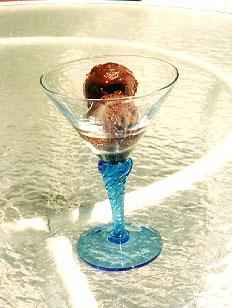Special Feature: Products Sally Recommends
Granita and Sorbet
 "I scream, you scream, we all scream for ice cream," is a familiar chant for one of America's favorite desserts. It's no surprise that this same enthusiasm carries over to ice cream's two cousins: granite and sorbet.
"I scream, you scream, we all scream for ice cream," is a familiar chant for one of America's favorite desserts. It's no surprise that this same enthusiasm carries over to ice cream's two cousins: granite and sorbet.
Whether you say it in French, granite (pronounced grah-nee-tay), or in Italian, granita (pronounced grah-nee-tah), granite and granita are the same: a grainy frozen mixture of sugar, water and a flavored liquid, such as coffee, lemon juice or even melted chocolate.
On the other hand, sorbet (French for sherbet), is a smooth, creamy frozen delicacy consisting of sugar, water, and most often, a fruit puree or fruit juice.
The main differences in these two ices (which contain basically the same ingredients) lies in the freezing method, the amount of sugar you use in proportion to the liquid in the recipe, and the texture in the finished product. Sorbet, prepared with a relatively high proportion of sugar to liquid, and frozen in a conventional, beater-type ice cream maker, has a creamy, smooth almost ice cream-like consistency. Granite has less sugar to liquid, is frozen in a large freezer-safe pan in the freezer section of your refrigerator and is stirred with a rubber spatula or raked with the tines of a fork about every 30 minutes to yield large, coarse ice crystals.
Incidentally, "sherbet" is technically an ice as well, containing sugar, water and fruit puree or fruit juice, but in this country we most often associate sherbet with the commercial milk sherbet sold in supermarkets. It's a fruit-flavored icy mixture that contains between 1 and 2 per cent milk fat. A milk sherbet is not as light or full of fruit as a granite or sorbet.
Granites and sorbets are characteristically light and refreshing, but intensely flavored, and sometimes tart and sweet at the same time as in the lemon granite. Both types of ices are versatile and delicious in a variety of flavors so you can serve them as a first course, an accompaniment to a fruit or leafy salad, as a dish between courses or of course, as dessert.
Both ices begin with a sugar syrup which are easy to make ahead and store perfectly in a covered container for days in the refrigerator. You can prepare the fruit ahead too, and store it in the refrigerator at least a day before using. Just stir the two mixtures to blend thoroughly before pouring into the container to freeze.
For best flavor and consistency, serve the lemon and coffee granites the same day you make them. However, the boysenberry sorbet tastes best when given some time in the freezer for its flavor and texture to mellow -- at least a few hours after making it. The sorbet keeps well in the freezer, up to five days.
![]()
Coffee Granite
makes 1 quart
Here's an ice that's crunchy, not-too-sweet yet deliciously flavored with coffee.
1 cup water
1/2 cup sugar
1 cup double-strength freshly brewed coffee
1 cup cold water
1 teaspoon vanilla
1/2 cup heavy cream, lightly whipped
In a small saucepan, heat 1 cup water with the sugar until sugar is dissolved. Refrigerate until cold. Combine sugar syrup with coffee, cold water and vanilla and blend together thoroughly. Pour into a freezer-safe container, such as a 9 x 13 x 2-inch metal pan. Freeze, stirring and scraping the mixture with a rubber spatula at first, then the tines of a fork every 30 to 40 minutes until a grainy consistency and completely frozen. This process takes 3 to 4 hours. Spoon into chilled stemmed glasses or bowls. Top each serving with a small dollop of softly whipped cream, if desired.
![]()
Lemon Granite
makes 7 cups
For the best flavor, always use freshly squeezed lemon juice.
1 cup water
2 cups sugar
1 1/2 cups (about 8 lemons) lemon juice
1 1/2 cups cold water
In a small saucepan, heat 1 cup water with the sugar until sugar is dissolved. Refrigerate until cold. Combine sugar syrup with lemon juice, cold water and blend together thoroughly. Pour into a freezer-safe container, such as a 9 x 13 x 2-inch metal pan. Freeze, stirring and scraping the mixture with a rubber spatula at first, then with the tines of a fork every 30 to 40 minutes until a grainy consistency and completely frozen. This process takes 3 to 4 hours. Spoon into chilled stemmed glasses or bowls.
![]()
Boysenberry Sorbet
makes 1 1/2 quarts
Add the juice of a lemon to offset the boysenberries' sweetness. If boysenberries aren't available, substitute blackberries.
2 cups water
2 1/4 cups sugar
3 pints (6 cups) boysenberries
juice of 1 lemon
In a saucepan, blend water and sugar together; bring just to a boil. Let cool, then refrigerate. Puree boysenberries in food processor or blender, strain through sieve to remove seeds. (Using a rubber spatula, keep pressing the berries against the sieve until most of the pulp comes away from the seeds.) Discard seeds and refrigerate puree.
Mix cold sugar syrup with cold puree and lemon juice. Freeze according to ice-cream maker's instructions. For a firmer sorbet, place sorbet in freezer for several hours. Let soften slightly before serving.
![]()
Flo Braker has been teaching baking techniques and her sweet miniatures across the country for twenty years and is the author of several cookbooks.
Note: This information was accurate when it was published. Please be sure to confirm all rates and details directly with the businesses in question before making your plans.



